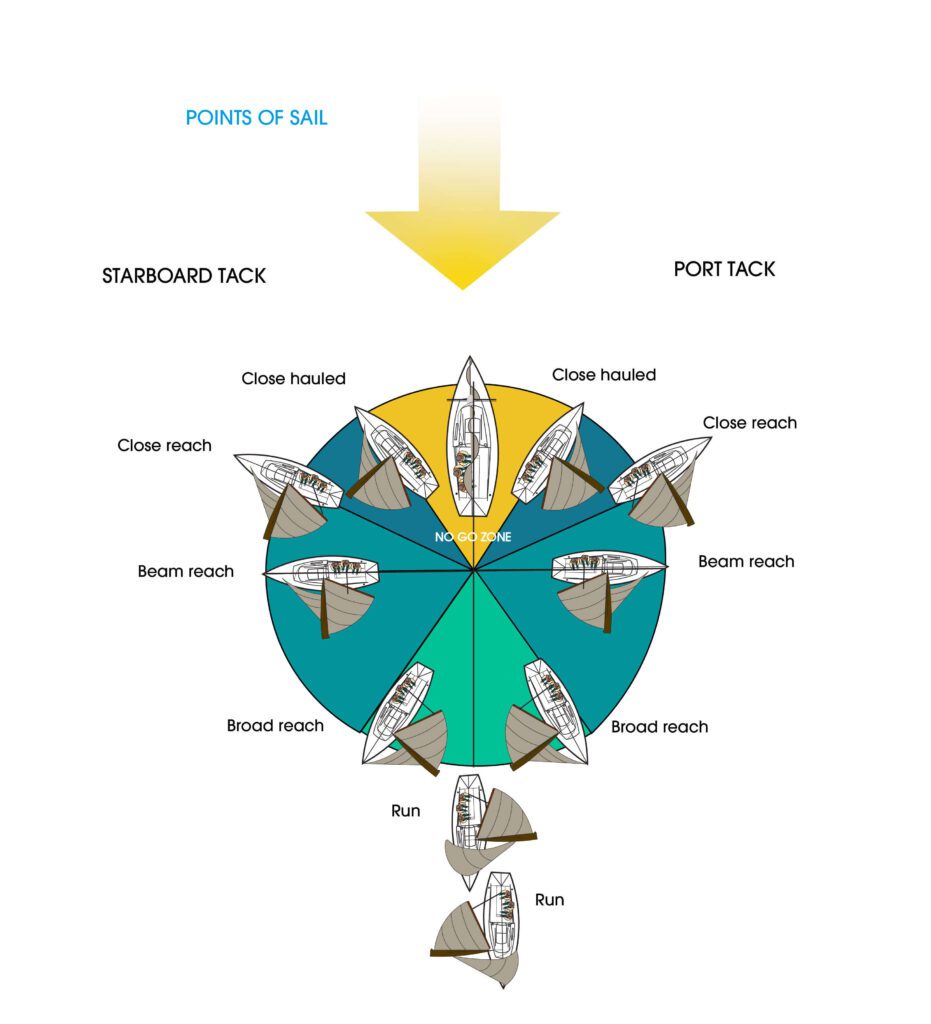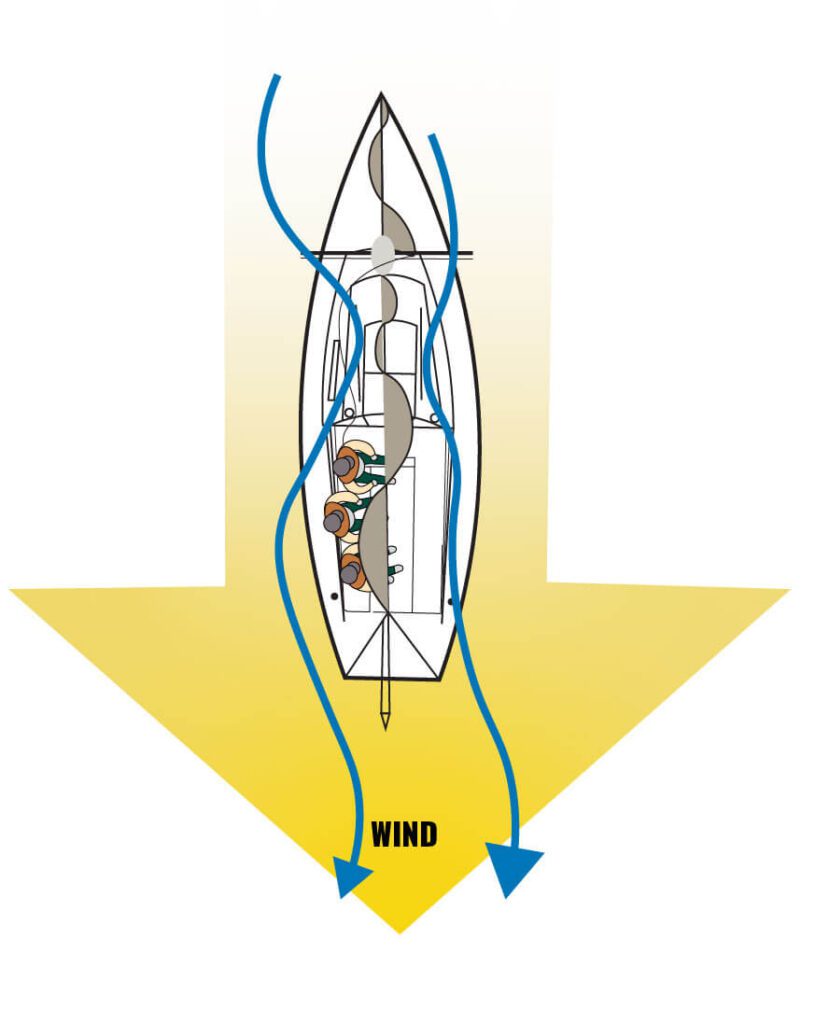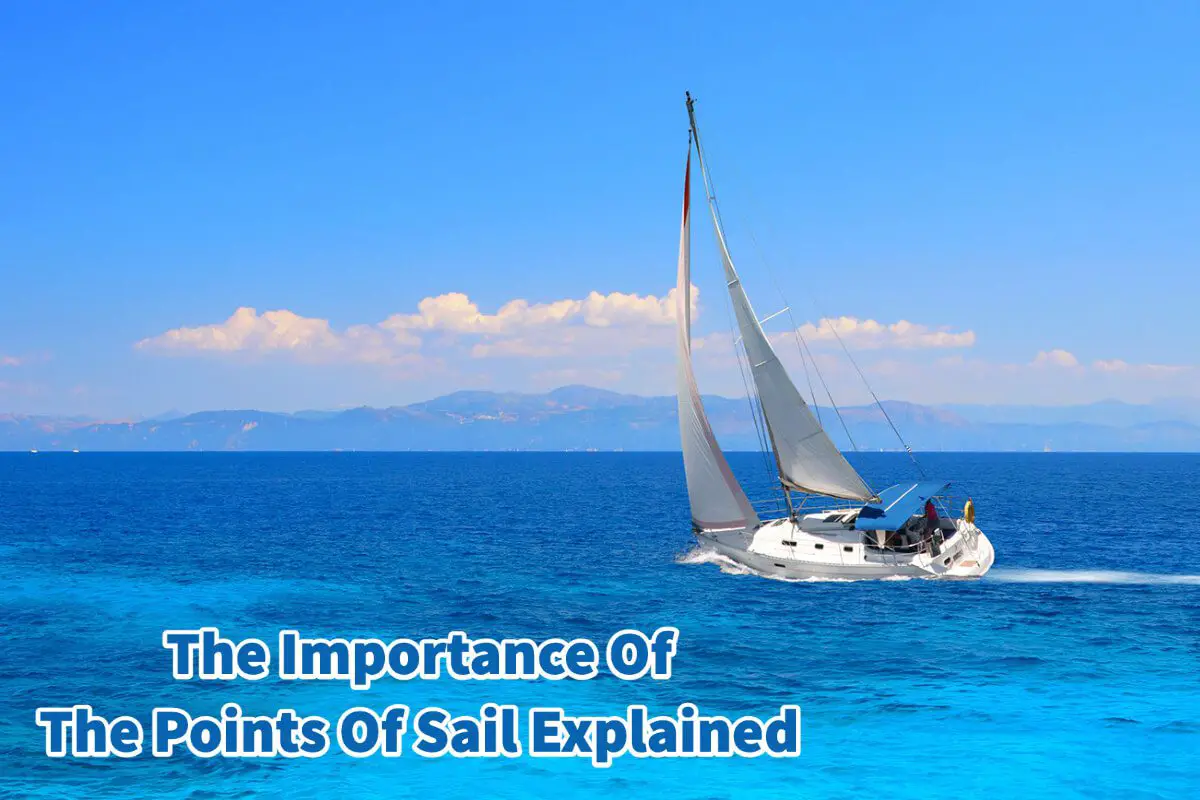Sailing is a sport requiring you to know and understand the wind and sail to sail a sailboat properly. One of the things that every sailor should understand is the point of the sail.
Points of sail are essential for any sailor to learn as they help you understand what direction the wind is coming from and how to position the sail to most effectively use the wind and main or gain speed. A sailor must also be able to read the telltales to know and understand the points of sail.
Table of Contents
The Points Of The Sail Are Explained
The points of sail refer to the different directions in which a sailboat can sail relative to the wind. There are eight points of sail, divided into three categories: the no-go zone, the close-hauled zone, and the beam reach, broad reach, and run zones. Understanding the points of sail is crucial for any sailor because it allows them to navigate their sailboat effectively and make the most of the wind.

The No-Go Zone Point Of Sail
A sailboat cannot sail directly into the wind or the no-go zone. A boat in the no-go zone will stop in its tracks; if you do not have a motor, you may need someone to help you get out of the zone.

Sometimes the no-go zone is also called “in irons.” The “in irons” is used in sailing to describe a situation where a sailboat is pointed directly into the wind and cannot make any headway.
When a sailboat is pointed directly into the wind, it cannot move as no wind can get in the sails. This occurs when the wind blows directly against the boat’s bow, causing the sails to luff or flap and lose their lift, and the boat loses momentum and becomes unresponsive to the helm.
History Of The Term “In-irons.”
The term “in irons” dates back to the early days of sailing, when ships were powered by wind alone and relied on sails to maneuver. The phrase is believed to have originated from putting the ship’s helm hard over to one side or the other, which would cause the ship to pivot around and face into the wind, with the sails flapping uselessly.
The term “in irons” comes from the idea that the ship is stuck, like a sword in its sheath. Some also say it refers to the fact that the prisoners were put in irons on the ships and could not move.
Over time, the term “in-irons” came to be used more broadly to refer to any situation where a sailboat cannot make headway due to the wind being directly against it.
Today, the term “in irons” describes a no-go zone for sailboats and is an essential concept for sailors to understand to avoid getting stuck in a difficult or dangerous situation.
The Close-Haul Zone Point Of Sail
The close-haul point of sail is one of the points of sail in sailing. It is the point of sail where the boat is sailing as close to the wind as possible, with the sails set at an angle of about 45 degrees to the wind.
This point of sail is sometimes called “close-reaching” or “close-winded.” When you are first learning to sail, it can be a challenging point of sail to master.
You are sailing just at the edge of the “no-go zone,” which can quickly put your sailboat “in irons”; your sailboat can stop as there is no wind in the sails.
When sailing on a close-haul point of sail, the sails are trimmed in tight, and the boat is heeled over to windward to reduce the amount of water resistance and increase its speed.
The helmsman must steer the boat at a close angle to the wind, adjusting the sails to maintain the boat’s speed and direction.
Sailing on a close-hauled course is one of the most efficient ways to sail upwind, allowing the boat to progress in the wind direction.
But it is also a challenging point of sail, as the boat is sailing against the wind and must maintain a delicate balance between speed and pointing ability; it is a point of sail that sailors should learn to master.
To sail on a close-hauled course, sailors must be able to adjust the sails quickly and accurately and steer the boat precisely to keep it on course. This requires a combination of skill, experience, and an understanding of the dynamics of sailing.
Overall, the close-haul point of sail is an essential point for sailors to master, as it is often used when sailing upwind and can make a significant difference in the boat’s speed and efficiency.
The Beam Reach Point Of Sail Explained
The beam reach point of sail is one of the points of sail in sailing. It is the point of sail where the wind is coming from the side of the boat, with the sails set perpendicular to the wind. This point of sail is sometimes called a “beam reach” or simply “reaching.”
The Beam Reach point of sail is easier to learn as you will see the telltales on the sail and the wind blowing straight over the beam.
When sailing on a beam reach, the sails are trimmed out slightly from the boat’s centerline, and the boat is heeled over slightly to leeward to balance the forces of the wind and the water. The helmsman must steer the boat carefully to maintain a steady course and avoid being pushed off course by the wind.
Sailing on a beam reach is generally considered a comfortable and accessible point of sail, as the boat is sailing with the wind coming from the side, and the sails are not under as much tension as they would be on other points of sail.
If you are a beginning sailor, this point of sail is usually popular with beginning and even more experienced sailors.
Sailing on a beam reach can also be dangerous, as the boat is vulnerable to sudden gusts of wind that can cause it to capsize or broach, so sailors need to understand the wind speed and direction when on a beam reach.
Sailors should always watch the wind closely and be prepared to adjust the sails and the boat’s course as necessary to maintain control.
The beam reach point of sail is essential for sailors to understand, as it is a comfortable and efficient point of sail that can be used in a wide range of sailing conditions. However, it is essential to continually sail cautiously and be prepared for sudden changes in the wind or weather.
The Broad Reach Point Of Sail Explained
The broad reach point of sail is one of the points of sail in sailing. It is the point of sail where the wind comes from behind the boat, with the sails set at an angle perpendicular to the wind and parallel to the boat’s centerline.
When sailing on a broad reach, the sails are trimmed out from the boat’s centerline, and the boat is heeled over slightly to leeward to balance the forces of the wind and the water. The helmsman must steer the boat carefully to maintain a steady course and avoid being pushed off course by the wind.
Sailing on a broad reach is generally considered a comfortable and accessible point of sail, as the boat is sailing with the wind coming from behind, and the sails are not under as much tension as they would be on other points of sail.
This is also a popular point of sale for cruising and racing. Sailing on a broad reach can also be dangerous, as the boat is vulnerable to sudden changes in wind direction and speed, especially if you are sailing in weather that changes frequently.
I know that when I sail on Lake Michigan, we must constantly watch the wind speed and telltales as the wind speed or direction can change frequently.
That is why sailors should always keep a close eye on the wind direction and wind speed and be prepared to adjust the sails and the course of the boat as necessary to maintain control.
The broad reach point of sail is essential for sailors to understand, as it is a comfortable and efficient point of sail that can be used in various sailing conditions.
The Run Point Of Sail Explained
The run point of sail is one of the points of sail in sailing. It is the point of sail where the wind comes from directly behind the boat, with the sails almost parallel to its centerline. This point of sail is sometimes called a “dead run” or simply “running.”
When sailing on the run, the sails are set out on either side of the boat, and the boat is heeled over slightly to leeward to balance the forces of the wind and the water. The helmsman must steer the boat carefully to maintain a steady course and avoid being pushed off course by the wind.
Sailing on the run is also a point of tell that you can tell if you look at the telltales on the sail and see that they are blowing straight towards the mast of the boat. This will tell you that the wind is blowing directly behind the boat.
Sailing on the run can be a comfortable and accessible point of sail, as the boat is sailing with the wind coming from directly behind, and the sails are not under as much tension as they would be on other points of sail. However, it can also be a challenging point of sail, as the boat is vulnerable to sudden wind direction and speed changes.
To maintain control while sailing on the run, sailors must keep a close eye on the wind and be prepared to adjust the sails and the boat’s course as necessary. This may involve techniques such as gybing (turning the boat downwind by crossing the stern through the wind) or adjusting the sails to maintain the boat’s speed and direction.
Overall, the run point of sail is essential for sailors to understand, as it is a comfortable and efficient point of sail that can be used in a wide range of sailing conditions. However, it is essential to continually sail with caution and be prepared for sudden changes in the wind or weather.
The Telltales And The Points Of Sail
Understanding the different points of sail is vital for sailors because it allows them to navigate their sailboats effectively and make the most of the wind. One of the essential things a sailor needs to learn is where the telltales will be pointing for each point of sail.
When they can read the telltales and what direction the wind is going from, they can understand which point of sail they need to use for which wind direction.
Knowing how to trim the sails and adjust the sailboat’s course to the wind direction is crucial for efficient sailing. Sailors need to be able to identify the point of sail they are on, adjust the sail trim and course accordingly, and, at the same time, understand how to read the telltales on the sail.
They must also know any wind direction or strength changes and adjust as needed. The telltales on the wind or if the sail is suddenly luffing can help them to understand what sail trims or adjustments need to be made.
Understanding Points Of Sail Is Important For Safety
In addition to navigation and speed, understanding the points of sail is also essential for safety. Sailors need to be aware of the direction of other sailboats and any obstacles in their path to avoid collisions. They must also know the weather conditions and any wind direction or strength changes to prevent capsizing or other accidents.
Understanding the points of sail is crucial for any sailor. It allows them to navigate their sailboat effectively, make the most of the wind, and ensure their safety. By learning the different points of sail and practicing sail trim and navigation skills; sailors can enjoy the thrill and excitement of sailing while also becoming skilled and competent sailors.
At A Bus On A Dusty Road, we discuss culture, travel, life, sailing, and ex-pat living. We are all about “Living Life As A Global Citizen.” We explore social, cultural, and economic issues and travel.
We would love to have you be part of our community. Sign up for our newsletter to keep up-to-date by clicking here. If you have any questions, please contact me, Anita, by clicking here.
Listen to our Podcast called Dusty Roads. You can find it on all major podcast platforms. Try out listening to one of our podcasts by clicking here.
Subscribe to our A Bus On A Dusty Road YouTube Channel with great videos and information by clicking here.
Frequently Asked Questions
What are the points of sail?
The points of sail are the different angles at which a sailboat can sail relative to the direction of the wind.
How many points of sail are there?
There are eight primary points of sail: close hauled, close reach, beam reach, broad reach, running, dead downwind, dead upwind, and in irons.
What is “close hauled”?
Close hauled is when a sailboat is sailing as close to the wind as possible, typically within about 45 degrees to either side of the wind.
What is a “close reach”?
Close reach is when a sailboat is sailing with the wind coming from about 45 degrees to 60 degrees off the bow.
What is a “beam reach”?
A beam reach is when a sailboat is sailing with the wind coming from approximately 90 degrees off the bow.
What is a “broad reach”?
A broad reach is when a sailboat is sailing with the wind coming from approximately 120 degrees to 150 degrees off the bow.
Why is understanding the points of sail important for a sailor?
Understanding the points of sail allows a sailor to effectively position the sails to maximize speed and efficiency by harnessing the power of the wind.
How can I determine the point of sail I’m on without instruments?
You can observe the direction the wind is coming from and compare it to the position of your sails relative to the boat to determine your point of sail.
Related Questions
What Is The Best Way To Remember The Points Of Sail When Sailing?
When you learn to sail, the wind is one of the most important things you must understand. In particular, you need to understand the points of a sail or exactly how the wind works with sailing.
In sailing, the points of sail are the No Go Zone, Close Haul, Close Reach, Beam Beach, Broad Reach, and Run. Understanding these and your sail’s position could help you push or pull your sailboat forward.
By clicking here, you can discover What Is The Best Way To Remember The Points Of Sail When Sailing?
What Is Tacking In Sailing? Steps To A Proper Tack
Tacking is when you move the boat’s bow into the wind to turn the boat’s direction. It is a very common maneuver that all sailors must learn to master. But with any sailing maneuver, their proper steps, you must know to do a good and safe tack.
By clicking here, you can discover What Is Tacking In Sailing? Steps To A Proper Tack
What Is The Sailing Term For “No Wind”?
The term calm or calm is used to describe sailing with no wind, or they’re no wind for you to be able to sell your sailboat. In ancient times, the sailors also used the word tied over to indicate that there was no wind, so they were tied over or stuck without being able to sail.
By clicking here, you can discover What Is The Sailing Term For “No Wind”?


